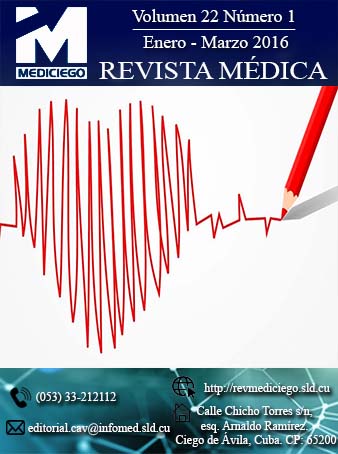Diagnosis in the family of the child with stuttering
Abstract
Introduction: stuttering is one of the most striking disorders of communication, with more and worse psychological impact, that affects children from an early age.
Objective: to determine the preparation level of family for the management of children with stuttering.
Method: a cross-sectional descriptive study was carried out in the Logofoniatria Consultation at Provincial General Teaching Hospital "Dr. Antonio Luaces Iraola" of Ciego de Avila. The sample was composed of 20 families of children who stutter, aged between 4 and 10 years who regularly attend this Consultation.
Results: 30 % of families maintain an adequate verbal environment, 25 % express an elementary knowledge of the disorder and 15 % do not have any knowledge about stuttering. All families agree that there are necessary –from detection of the disorder– the preparation and the link to the ways and modes of action to promote a proper communication environment, but they not used intentionally psychological resources to stabilize the emotions of children: 25 % of families are patient and wait for the children finish speaking; 20 % ignore them, and 55 % manifest an anxious, desperate, tense behavior regarding the difficulties of their children.
Conclusions: families do not have sufficient knowledge for the correct handling of children who stutter. It is confirmed the need for preparation of families in the essential aspects of this oral disorder, to influence corrective and remedial work of the sameDownloads
Published
How to Cite
Issue
Section
License
Copyright (c) 2021 María Teresa Cepero García, Alina Alonso Herrera, Bárbara Mercedes Rodríguez Ortiz, Danieyisis Vega Fernández

This work is licensed under a Creative Commons Attribution 4.0 International License.
Those authors who have publications with this journal accept the following terms of the License CC Attribution-NonCommercial 4.0 International (CC BY-NC 4.0):
You are free to:
- Share — copy and redistribute the material in any medium or format for any purpose, even commercially.
- Adapt — remix, transform, and build upon the material for any purpose, even commercially.
The licensor cannot revoke these freedoms as long as you follow the license terms.
Under the following terms:
- Attribution — You must give appropriate credit , provide a link to the license, and indicate if changes were made . You may do so in any reasonable manner, but not in any way that suggests the licensor endorses you or your use
- No additional restrictions — You may not apply legal terms or technological measures that legally restrict others from doing anything the license permits.
The journal is not responsible for the opinions and concepts expressed in the works, which are the exclusive responsibility of the authors. The Editor, with the assistance of the Editorial Committee, reserves the right to suggest or request advisable or necessary modifications. Original scientific works are accepted for publication, as are the results of research of interest that have not been published or sent to another journal for the same purpose.
The mention of trademarks of specific equipment, instruments or materials is for identification purposes, and there is no promotional commitment in relation to them, neither by the authors nor by the editor.






















